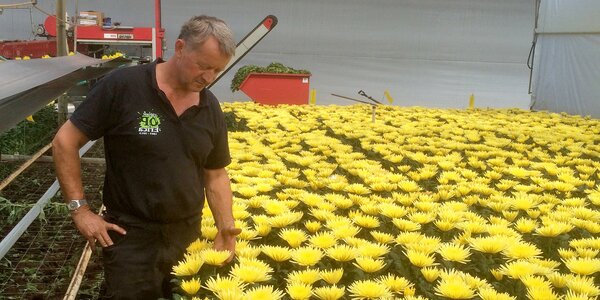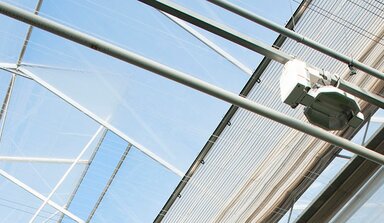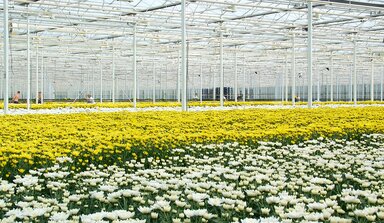Chrysanthemums under ReduFuse
If the crop can remain active for longer on warm days it can also mean extra yield. In order to achieve that chrysanthemum grower Jan Boerma has been using ReduFuse.
It’s always a case of finding the right balance between allowing in enough light to maximise the crop’s potential and shading out the light to guarantee the quality of the crop. Chrysanthemums are sensitive to flower burn so you have to be careful with this crop. The Boerma-Eefting Partners, of Erica in Drente, the Netherlands, had already tried ReduHeat before they started to use the diffuse coating ReduFuse. “Without a coating we certainly need to close the shade screens for an extra two hours per day,” says Boerma. “That means we lose a lot of light. Now we can cose the screens at 600 Watt instead of 450 Watt, which we used to do before. Under ReduFuse we see extra growth, heavier stems and a more uniform crop.”

Jan Boerma
Crop in momentum
The diffuse light penetrates deeper into the crop, which results in more growth and uniformity. The crop has more momentum and is more active. Therefore it transpires for longer on warmer days. The grower can also allow a higher greenhouse temperature (the settings are 2°C higher). “The plants also need more water,” he says. “During the period from mid-May to mid-August this can amount to 30% more. Then we clearly see a higher air humidity due to the greater amount of transpiration.”
Right timing for application
Boerma grows 1.5 ha of disbudded chrysanthemum (Anastasia). Before 2013 he used ReduHeat but he saw good reasons to switch over to a diffuse coating, in particular for the expected (slightly) higher yield and uniformity due to the better distribution of light. However, it was a puzzle to find precisely the right time to apply the coating. “In the first year we decided to apply it at the beginning of May. In hindsight that was just a bit too late; then the chance of flower burn is already quite large. The following year we were more cautious and coated at the beginning of March. That appeared to be too early; you do lose light. We’ve concluded that the end of March is the best time. We remove it around mid-September. Then there is no risk of flower burn.”
Better climate for crop and people
A positive point is that the working environment has become better. Not only does the crop remain more active on warmer days, so do the employees. In general Boerma is pleased that he chose ReduFuse: “The cost:benefit ratio is acceptable. A negative point is the light loss. In addition you do need to slightly adjust your cultivation measures. On warm days we purposefully allow less wind into the greenhouse and we ventilate less on the sunny side. Watering is a point of particular consideration and it seems that the growth inhibitors work more intensely. You certainly need to take this into account.”

